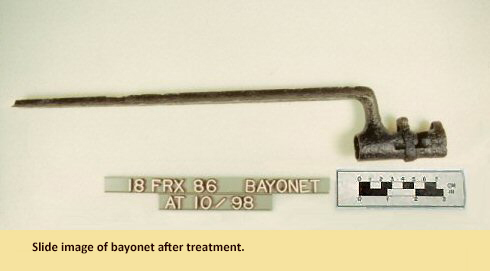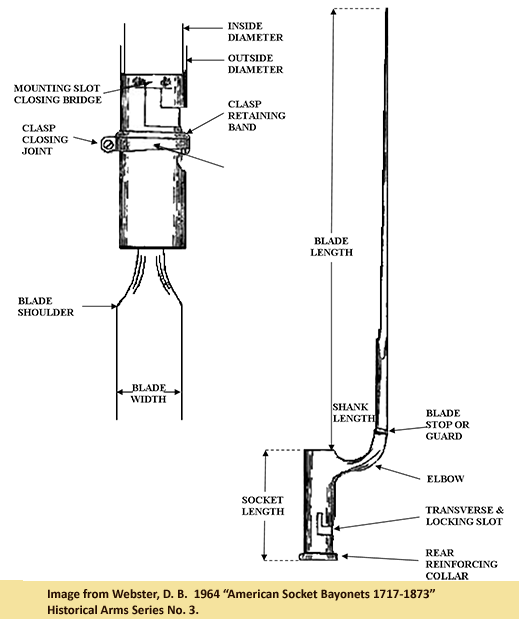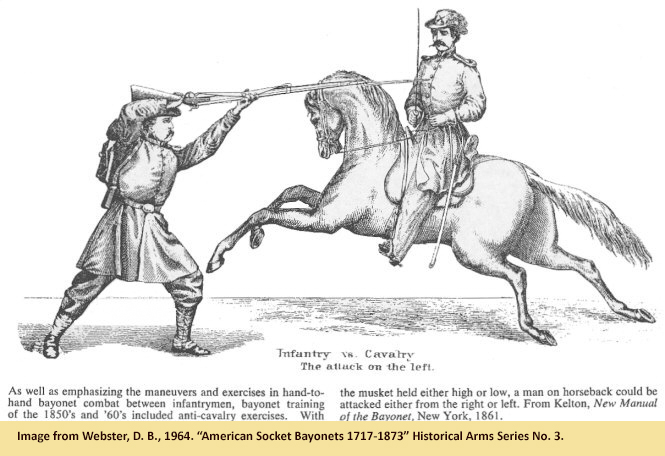A Model 1855 Civil War Bayonet
January 2009
By Gareth McNair-Lewis, MAC Lab Conservation Technician
 According to a newspaper account, this Civil War bayonet was found by construction workers digging between W. Patrick Street and Court Street in the town of Frederick, Maryland during the Carroll Creek project. Frederick's status as a major crossroads put it at the center of campaigns during the Civil War, and saw both Union and Confederate troops march through the city. The Monacacy battlefield lies just outside the city’s limits.
According to a newspaper account, this Civil War bayonet was found by construction workers digging between W. Patrick Street and Court Street in the town of Frederick, Maryland during the Carroll Creek project. Frederick's status as a major crossroads put it at the center of campaigns during the Civil War, and saw both Union and Confederate troops march through the city. The Monacacy battlefield lies just outside the city’s limits.
The physical dimensions of the diagnostic features
on this bayonet, such as blade length, width, socket length and shank length, identify it as a model 1855 bayonet. These features remained standard on many successive models up until 1873 (Webster 1964). In fact the Model 1855 bayonets are virtually identical in appearance to the US Model 1873. This bayonet is typical of the period and was originally produced for the Model 1855 Springfield rifle (Shuey 1999). It is offset, meaning it has a cylindrical  socket which fits around a musket barrel and the shank is at right angles to the socket. The mounting slot closing bridge greatly strengthens the socket cylinder. The bayonet also features an L-shaped transverse and locking slot, locking clasp, closing joint and clasp retaining band.
socket which fits around a musket barrel and the shank is at right angles to the socket. The mounting slot closing bridge greatly strengthens the socket cylinder. The bayonet also features an L-shaped transverse and locking slot, locking clasp, closing joint and clasp retaining band.
This particular bayonet was found in fairly good condition, except that six inches of the blade tip is broken off and missing, not uncommon for a weapon that probably saw considerable action. Even though every soldier during the Civil War was issued a bayonet for his musket, the weapon was rarely used in combat. The improvement in rifle accuracy in the 1860s meant that soldiers seldom engaged one another up close. Many relics found at battlefield sites indicate that some bayonets were altered with the help of the company's blacksmith to be used as tent pegs, picket pins, candlesticks, pot hooks, entrenching tools, pry bars and even can openers (Shuey 1999).
In initial inspection of the bayonet, it was noted that some of the iron edges of its triangular blade were missing and there was some delamination and surface pitting due to corrosion. When first brought to the MAC Lab, the bayonet was still encased in burial dirt.
A treatment was proposed that is fairly standard for iron in relatively good condition; it was placed for a short time in electrolytic reduction in a sodium carbonate solution at low amperage, followed by manual removal of corrosion, encrustation and soil. Next, hot wash baths in de-ionized water and chloride tests determined when it was ready for coating with tannic acid, a corrosion inhibitor, and finally the surface was coated with microcrystalline wax in order to prevent further corrosion and degradation.

| References |
|
| Shuey, R.W. |
| 1999 |
Socket Bayonets of the Great Powers: A Collector's Guide. Excalibur Publications. Tucson, AZ. |
|
| Webster, D. B. |
| 1964 |
American Socket Bayonets 1717-1873. Historical Arms Series. No.3. |
|